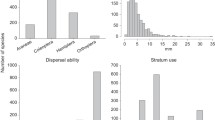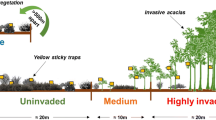Abstract
Agroforestry systems in the tropics exhibit high heterogeneity in plant species composition and structural configuration. However, few studies evaluated the seasonal shift in arthropod alpha diversity and abundance in agroforestry systems in the tropics. This study was designed to analyze the composition, abundance, and alpha diversity of arthropod orders in five agroforestry systems in the humid tropic of Tabasco, Mexico. The agroforestry systems compared were shade trees in plantations (ShTP), living fences (LF), alley farming (AF), slash-and-burn agriculture (SBA), and grazing plantations (GP) during dry and rainy seasons. Arthropods were collected using pitfall traps, classified at the order level, and counted to estimate the abundance. A total of 10,271 arthropod individuals were collected that belong to seven orders. Hymenoptera was the most abundant group, accounting for 64.7% of the total count, followed by Coleoptera, Collembola, Araneae, Hemiptera, Diptera, and Orthoptera. Arthropod alpha diversity and abundance varied significantly among the agroforestry systems and between the rainy and dry seasons. The agroforestry systems AF, GP, and ShTP showed a higher diversity (Shannon index) and dominant orders (Simpson index) in the rainy season compared to the dry season. The seasonal shift of the different arthropod orders varied among agroforestry systems, while the Orthoptera did seasonally vary across the agroforestry systems. This study suggests the interactive effects of seasons and agroforestry systems on arthropod abundance and diversity.







Similar content being viewed by others
Data Availability
The data used in the research will be available without access restrictions, but will have to be requested from the authors.
References
Aryal DR, De Jong BH, Ochoa-Gaona S, Mendoza-Vega J, Esparza-Olguin L (2015) Successional and seasonal variation in litterfall and associated nutrient transfer in semi-evergreen tropical forests of SE Mexico. Nutr Cycl Agroecosyst 103:45–60
Asfiya WARA, Lach L, Majer JD, Heterick BRIAN, Didham RK (2015) Intensive agroforestry practices negatively affect ant (Hymenoptera: Formicidae) diversity and composition in southeast Sulawesi. Indonesia Asian Myrmecol 7(1):87–104
Ashraf M, Zulkifli R, Sanusi R, Tohiran KA, Terhem R, Moslim R, Norhisham AR, Butt AA, Azhar B (2018) Alley-cropping system can boost arthropod biodiversity and ecosystem functions in oil palm plantations. Agr Ecosyst Environ 260:19–26
Atangana A, Khasa D, Chang S, Degrande A (2014) Definitions and classification of agroforestry systems. Tropical Agroforestry. Springer, Dordrecht, pp 35–47
Barros E, Neves A, Blanchart E, Fernandes E, Wandelli E, Lavelle P (2003) Development of the soil macrofauna community under silvopastoral and agrisilvicultural systems in Amazonia. Pedobiologia 47(3):273–280
Belchior C, Sendoya SF, Del-Claro K (2016) Temporal variation in the abundance and richness of foliage-dwelling ants mediated by extrafloral nectar. PLoS ONE 11(7):e0158283
Boinot S, Poulmarc’h, J., Mézière, D., Lauri, P. É., & Sarthou, J. P (2019) Distribution of overwintering invertebrates in temperate agroforestry systems: Implications for biodiversity conservation and biological control of crop pests. Agr Ecosyst Environ 285:106630
Casanova-Lugo F, Villanueva-López G, Alcudia-Aguilar A, Nahed-Toral J, Medrano-Pérez OR, Jiménez-Ferrer G, Alayón-Gamboa JA, Aryal DR (2022) Effect of tree shade on the yield of Brachiaria brizantha grass in tropical livestock production systems in mexico. Rangel Ecol Manage 80:31–38
de Lima ALC, Manhães MA (2017) Seasonal variation of understory insectivorous birds and arthropods in an area of secondary Atlantic forest, southeast Brazil. Revista Brasileira De Ornitologia 25(1):47–53
de Abreu PLF, de Souza ALT, Tanaka MO, Labarque FM, Soares JAH (2020) Interactive effects between vegetation structure and soil fertility on tropical ground-dwelling arthropod assemblages. Appl Soil Ecol 155:1–9
de Pedro L, Perera-Fernández LG, López-Gallego E, Pérez-Marcos M, Sanchez JA (2020) The effect of cover crops on the biodiversity and abundance of ground-dwelling arthropods in a Mediterranean pear orchard. Agronomy 10(4):580
Dierks J, Blaser-Hart WJ, Gamper HA, Nyoka IB, Barrios E, Six J (2021) Trees enhance abundance of arbuscular mycorrhizal fungi, soil structure, and nutrient retention in low-input maize cropping systems. Agric Ecosyst Environ 318:1–11
Ellis EA, Romero Montero JA, Hernández Gómez IU (2017) Deforestation processes in the state of Quintana Roo, Mexico: the role of land use and community forestry. Tropical Conserv Sci 10:1–12
Entling W, Schmidt MH, Bacher S, Brandl R, Nentwig W (2007) Niche properties of central European spiders: shading, moisture and the evolution of the habitat niche. Glob Ecol Biogeogr 16:440–448
Forister ML, Pelton EM, Black SH (2019) Declines in insect abundance and diversity: we know enough to act now. Conserv Sci Practice 1(8):1–8
Goehring DM, Daily GC, Şekerçioglu ÇH (2002) Distribution of ground-dwelling arthropods in tropical countryside habitats. J Insect Conserv 6(2):83–91
Ilyas M, Nisar M, Khan N, Hazrat A, Khan AH, Hayat K, Fahad S, Khan A, Ullah A (2021) Drought tolerance strategies in plants: a mechanistic approach. J Plant Growth Regul 40:926–944
Kishimoto-Yamada K, Itioka T (2015) How much have we learned about seasonality in tropical insect abundance since Wolda (1988)? Entomological Science 18(4):407–419
Kissinger, G. M., Herold, M., & De Sy, V. (2012). Drivers of deforestation and forest degradation: a synthesis report for REDD+ policymakers. Lexeme Consulting.
Langellotto GA, Denno RF (2004) Responses of invertebrate natural enemies to complex-structured habitats: a meta-analytical synthesis. Oecologia 139(1):1–10
Lawson DA, Rands SA (2019) The effects of rainfall on plant–pollinator interactions. Arthropod-Plant Interactions 13(4):561–569
Liu CA, Liang MY, Tang JW, Jin YQ, Guo ZB, Siddique KH (2021) Challenges of the establishment of rubber-based agroforestry systems: Decreases in the diversity and abundance of ground arthropods. J Environ Manage 292:112747
McCluney KE, George T, Frank SD (2018) Water availability influences arthropod water demand, hydration and community composition on urban trees. J Urban Ecol 4(1):1–8
Moço MKS, Gama-Rodrigues EF, Gama-Rodrigues AC, Machado RC, Baligar VC (2010) Relationships between invertebrate communities, litter quality and soil attributes under different cacao agroforestry systems in the south of Bahia. Brazil Applied Soil Ecol 46(3):347–354
Noriega JA, Hortal J, Azcárate FM, Berg MP, Bonada N, Briones MJI, Del Toro I, Goulson D, Ibanez S, Landis DA, Moretti M, Potts SG, Slade EM, Stout JC, Ulyshen MD, Wackers FL, Woodcock BA, Santos AMC (2018) Research trends in ecosystem services provided by insects. Basic Appl Ecol 26:8–23
Palma-López DJ, Cisneros-Domínguez J, Moreno-Cáliz E, Rincón-Ramírez JA (2007) Suelos de Tabasco: su uso y manejo sustentable. Colegio de Postgraduados-Isprotab-Fuprotab Villahermosa, México, p 195
Pétillon J, Georges A, Canard A, Lefeuvre JC, Bakker JP, Ysnel F (2008) Influence of abiotic factors on spider and ground beetle communities in different salt-marsh systems. Basic Appl Ecol 9(6):743–751
Pinheiro F, Diniz IR, Coelho D, Bandeira MPS (2002) Seasonal pattern of insect abundance in the Brazilian cerrado. Austral Ecol 27(2):132–136
Prather, R. M., Castillioni, K., Welti, E. A., Kaspari, M., & Souza, L. (2020). Abiotic factors and plant biomass, not plant diversity strongly shape grassland arthropods under drought conditions 101(6): 1–17
Ramos DL, Cunha WL, Evangelista J, Lira LA, Rocha MVC, Gomes PA, Frizzas MR, Togni PHB (2020) Ecosystem services provided by insects in Brazil: What do we really know? Neotrop Entomol 49(6):783–794
Randlkofer B, Obermaier E, Hilker M, Meiners T (2010) Vegetation complexity—the influence of plant species diversity and plant structures on plant chemical complexity and arthropods. Basic Appl Ecol 11(5):383–395
Richards LA, Windsor DM (2007) Seasonal variation of arthropod abundance in gaps and the understorey of a lowland moist forest in Panama. J Trop Ecol 23(2):169–176
Rivera-Hernández B, Aceves Navarro LA, Juárez López JF, Méndez Adorno JM, Ramos Álvarez C (2016) Evidencias del cambio climático en el estado de Tabasco durante el periodo 1961–2010. Revista Mexicana De Ciencias Agrícolas 7(SPE14):2645–2656
Ruíz-Álvarez O, Arteaga-Ramírez R, Vázquez-Peña MA, OntiverosE. E. López-López, R C (2012) Water balance and climatic classification of the state of tabasco. Mexico Universidad y Ciencia 28(1):1–14
Salazar JCS, Bautista EHD, Patiño GR (2015) Soil macrofauna associated to agroforestry systems in Colombian Amazon. Soil Sci Chem Phys Biol Biochem Hydrol 64(3):214–220
Sánchez-Silva S, De Jong BH, Aryal DR, Huerta-Lwanga E, Mendoza-Vega J (2018) Trends in leaf traits, litter dynamics and associated nutrient cycling along a secondary successional chronosequence of semi-evergreen tropical forest in Southeastern Mexico. J Trop Ecol 34(6):364–377
Sari RR, Rozendaal DM, Saputra DD, Hairiah K, Roshetko JM, van Noordwijk M (2022) Balancing litterfall and decomposition in cacao agroforestry systems. Plant Soil 473(1–2):251–271
Silva NAPD, Frizzas MR, Oliveira CMD (2011) Seasonality in insect abundance in the “Cerrado” of Goiás State, Brazil. Revista Brasileira De Entomologia 55:79–87
Silveira JM, Barlow J, Andrade RB, Louzada J, Mestre LA, Lacau S, Zanetti R, Numata I, Cochrane MA (2013) The responses of leaf litter ant communities to wildfires in the Brazilian Amazon: a multi-region assessment. Biodivers Conserv 22:513–529
Suárez SJC, DuranB. E. H. Rosas, P. G EH (2015) Soil macrofauna associated to agroforestal systems in Colombian Amazon. Acta Agronómica 64:214–220
Traba J, Morales MB, García de la Morena EL, Delgado MP, Krištín A (2008) Selection of breeding territory by little bustard (Tetrax tetrax) males in Central Spain: the role of arthropod availability. Ecol Res 23(3):615–622
Vasconcellos A, Andreazze R, Almeida AM, Araujo HF, Oliveira ES, Oliveira U (2010) Seasonality of insects in the semi-arid Caatinga of northeastern Brazil. Revista Brasileira De Entomologia 54:471–476
Villanueva-López G, Martínez-Zurimendi P, Ramírez-Avilés L, Raj Aryal D, Casanova-Lugo F (2016) Live fences reduce the diurnal and seasonal fluctuations of soil CO2 emissions in livestock systems. Agron Sustain Dev 36:1–8
Villanueva-López G, Lara-Pérez LA, Oros-Ortega I, Ramírez-Barajas PJ, Casanova-Lugo F, Ramos-Reyes R, Aryal DR (2019) Diversity of soil macro-arthropods correlates to the richness of plant species in traditional agroforestry systems in the humid tropics of Mexico. Agric Ecosyst Environ 286:1–8
Wagner DL, Grames EM, Forister ML, Berenbaum MR, Stopak D (2021) Insect decline in the Anthropocene: Death by a thousand cuts. Proc Natl Acad Sci 118(2):1–10
Wolda H (1988) Insect seasonality: why? Annu Rev Ecol Syst 19(1):1–18
Yamazaki L, Vindica VF, Marques MI, Battirola LD (2020) Arthropods associated with Callisthene fasciculata (Vochysiaceae) canopy in the Pantanal of Mato Grosso. Brazil Revista Colombiana De Entomología 46(1):e10168
Zeng Z, Wang D, Yang L, Wu J, Ziegler AD, Liu M, Ciais P, Searchinger TD, Yan ZL, Chen D, Chen A, Li LZX, Piao S, Taylor D, Cai X, Pan M, Peng L, Lin P, Gower D, Feng Y, Zheng C, Guan K, Lian X, Wang T, Wang L, Jeong SJ, Wei Z, Sheffield J, Caylor K, Wood EF (2021) Deforestation-induced warming over tropical mountain regions regulated by elevation. Nat Geosci 14(1):23–29
Zhou D, Xiao J, Frolking S, Liu S, Zhang L, Cui Y, Zhou G (2021) Croplands intensify regional and global warming according to satellite observations. Remote Sens Environ 264:1–18
Acknowledgements
The authors thank the Consejo Nacional de Ciencia y Tecnología for financially supporting research project number TAB-2006-C08-43867. We also thank El Colegio de la Frontera Sur for the support with infrastructure and financing to carry out this research.
Funding
Consejo Nacional de Ciencia y Tecnologia, TAB-2006-C08-43867, Gilberto Villanueva López
Author information
Authors and Affiliations
Corresponding author
Ethics declarations
Competing interest
The authors declare that they have no conflict of interests.
Additional information
Handling Editor: Severin Hatt
Publisher's Note
Springer Nature remains neutral with regard to jurisdictional claims in published maps and institutional affiliations.
Supplementary Information
Below is the link to the electronic supplementary material.
Rights and permissions
Springer Nature or its licensor (e.g. a society or other partner) holds exclusive rights to this article under a publishing agreement with the author(s) or other rightsholder(s); author self-archiving of the accepted manuscript version of this article is solely governed by the terms of such publishing agreement and applicable law.
About this article
Cite this article
Lara-Pérez, L.A., Villanueva-López, G., Oros-Ortega, I. et al. Seasonal variation of arthropod diversity in agroforestry systems in the humid tropics of Mexico. Arthropod-Plant Interactions 17, 799–810 (2023). https://doi.org/10.1007/s11829-023-10001-0
Received:
Accepted:
Published:
Issue Date:
DOI: https://doi.org/10.1007/s11829-023-10001-0




